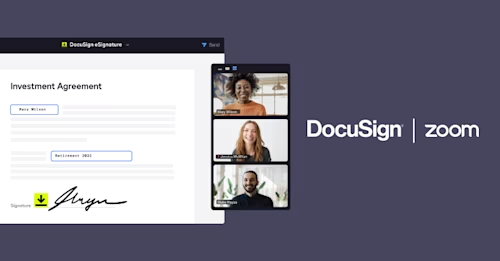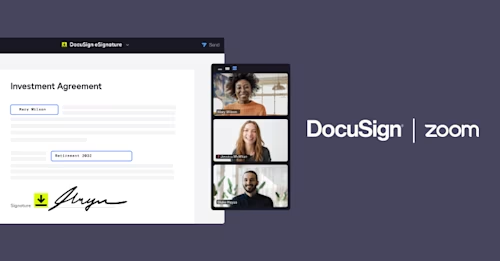
Remote unterschreiben neu erleben mit Docusign eSignature für Zoom
Deshalb freuen wir uns, mitteilen zu können, dass Docusign eine Partnerschaft mit Zoom eingeht.

Eine wichtige Entwicklung der Pandemie war die Transformation zur "Anywhere Economy", in der man alltägliche Aufgaben - privat oder beruflich - praktisch von überall aus erledigen kann. Sie können jetzt online ein Bankkonto eröffnen, Dokumente über Kontinente hinweg in nur wenigen Minuten unterzeichnen und Ihre Identität gemütlich von Ihrem Wohnzimmer aus online bestätigen - und das alles ohne irgendwohin zu reisen, um persönlich vor Ort zu sein.
Moderne Organisationen implementieren neue Technologien, um die Geschäfte für ihre Mitarbeiter, Mitarbeiterinnen, Kunden und Partner am Laufen zu halten. Untersuchungen von Docusign haben ergeben, dass die beiden wichtigsten Tools, in die Unternehmen in dieser Zeit investiert haben, elektronische Signaturen und Videokonferenzsoftwares sind. Docusign eSignature ermöglicht es Unternehmen, Verträge sicher und effizient elektronisch zu unterzeichnen, was Zeit und Kosten spart.

Deshalb freuen wir uns, mitteilen zu können, dass Docusign eine Partnerschaft mit Zoom Video Communications, Inc. eingeht, der führenden Videokommunikationsplattform, um es Kunden und Kundinnen noch einfacher zu machen, Vereinbarungen von überall aus abzuschließen. Docusign eSignature für Zoom ermöglicht es Unternehmen, Vertragsprozesse mit virtuellen, persönlichen Unterzeichnungserfahrungen neu zu gestalten. So können sie die Zeit bis zum Vertragsabschluss verkürzen - und gleichzeitig Vertrauen und Loyalität aufbauen.
"Mitarbeiter wollen nicht dauernd zwischen unzähligen Apps und E-Mails hin und her wechseln – besonders, wenn sie mit Kunden, Kundinnen oder Partnern zusammenarbeiten. Stattdessen benötigen sie Tools, die Arbeitsabläufe und die Zusammenarbeit mit anderen einfacher machen", sagt Ross Mayfield, Produktleiter, Zoom Apps & Integrations. "Wir sind begeistert von Docusign eSignature für Zoom, da es den Beteiligten ermöglicht, Vereinbarungen vor der Unterzeichnung gemeinsam in Echtzeit zu überprüfen, was dazu beiträgt, Kommunikationssilos zu beseitigen und den Abschluss von Vereinbarungen zu beschleunigen."
"Die letzten Jahre haben den Bedarf an Flexibilität und besseren Produktivitätstools deutlich gemacht, um die sich entwickelnden Bedürfnisse der Kunden und Kundinnen zu erfüllen. Wir freuen uns deshalb sehr über die Partnerschaft mit Zoom und dass wir Unternehmen die Docusign eSignature App für Zoom anbieten können. Damit ermöglichen wir Vertragspartnern, effizienter zusammenzuarbeiten und Verträge in der neuen "Anywhere Economy" abzuschließen." Jerome Levadoux, SVP von Sign, Docusign
Sie können direkt von Zoom aus Vereinbarungen sicher teilen, überprüfen und abschließen
Schaffen Sie Vertrauen und Loyalität durch eine vernetzte Erfahrung
Bei Vertragsverhandlungen möchten Unterzeichner und Unterzeichnerinnen vor der Unterzeichnung oft noch Details besprechen. Anstatt sich persönlich zu treffen oder per E-Mail hin und her zu diskutieren, können Sie Details jetzt live in Zoom besprechen. Sobald Sie die Details geklärt haben, können die Unterzeichner die Vereinbarung live unterschreiben und abschließen. Die Unterzeichner benötigen weder ein Zoom-Konto noch ein Docusign-Konto - sie müssen nur zum Treffen erscheinen.
Beschleunigen Sie Vertragsprozesse
Greifen Sie von Ihrem Zoom-Meeting aus ganz einfach auf die Docusign eSignature App zu. Anstatt einen Unterzeichner zu bitten, seine E-Mail zu durchsuchen, um die Vereinbarung zu finden, zu teilen und zu unterzeichnen, können Sie die Vereinbarung in der eSignature-App im Apps-Menü Ihres Zoom-Meetings finden und sie ihm direkt in Zoom präsentieren.
Reduzieren Sie Risiken mit einer verbesserten Unterzeichner-Identifizierung
Sie können Ihre Vereinbarungen schützen, indem Sie Docusigns erweiterte Methoden zur Unterzeichner-Identifizierung mit Docusign eSignature für Zoom nutzen - egal ob Sie eine einfache Authentifizierung oder eine strengere ID-Verifizierung benötigen. Zum Beispiel können Sie während Ihrer Videokonferenz automatisch den amtlichen Lichtbildausweis oder die eID eines Unterzeichners oder einer Unterzeichnerin in Echtzeit mit der ID-Verifizierung sicherstellen.
Gewinnen Sie mehr Kontrolle über das, was Sie teilen
Mit der eSignature App für Zoom geben Sie nur die relevante Vereinbarung frei. Unterzeichner können Ihren Desktop, Ihre Browserfenster oder Ihre anderen Docusign-Vereinbarungen nicht sehen - das hilft Ihnen, Sicherheitsrisiken zu reduzieren.
So funktioniert es:
Installieren Sie die Docusign eSignature App aus dem Zoom App Marketplace
Bereiten Sie Ihre Vereinbarung vor und senden Sie sie per E-Mail oder SMS vor dem Zoom-Meeting
Starten Sie das Zoom-Meeting mit dem Unterzeichner
Öffnen Sie das Docusign eSignature Apps Menü in Ihrem Zoom Meeting
Suchen Sie Ihre Vereinbarung im rechten Bereich und wählen Sie den Namen des Unterzeichners
Übergeben Sie die Kontrolle an den Unterzeichner und besprechen Sie die Details der Vereinbarung
Der Unterzeichner füllt alle Felder aus und unterschreibt
Alle Parteien erhalten eine Kopie der Vereinbarung
Docusign eSignature für Zoom kann für fast jede Vereinbarung in jeder Abteilung und Branche verwendet werden, um Unterschriften sicher digital einzuholen.
Übliche Anwendungsfälle sind:
Verkaufsverträge
Onboarding-Formulare für neue Mitarbeiter und Mitarbeiterinnen
Übertragungen in der Vermögensverwaltung
Service-Aktivierung
Versicherungsansprüche und -policen
Onboarding neuer Kunden und Kundinnen
Aufnahmeformular (Anamnesebogen) für Patienten und Patientinnen
Sind Sie bereit, loszulegen? Installieren Sie einfach die neue Docusign eSignature App für Zoom. Lesen Sie zudem unseren Docusign eSignature-Leitfaden, um zu erfahren, wie Sie das Beste aus der Integration herausholen können. Erfahren Sie auch, wie Sie Dokumente elektronisch auf Ihrem iPhone oder iPad signieren können, um die Flexibilität der elektronischen Signatur voll auszunutzen.

Ähnliche Beiträge
Docusign IAM ist die Vertragsplattform, die Ihr Unternehmen braucht



